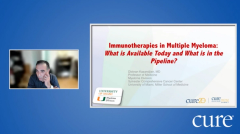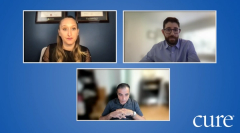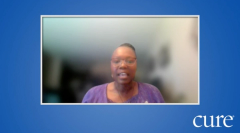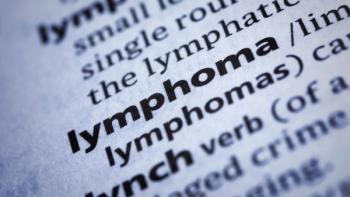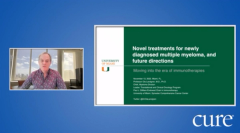
Educated Patient® Multiple Myeloma Summit Therapy and Beyond Panel: November 13, 2022
Watch Dr. Dickran Kazandjian and Dr. Benjamin Diamond answer questions about therapeutic options during the CURE® Educated Patient® Multiple Myeloma Summit.
Episodes in this series

This panel was moderated by Kristie L. Kahl, and included Dr. Dickran Kazandjian, from Miami Sylvester Comprehensive Cancer Center, and Dr. Benjamin Diamond, from Miami Sylvester Comprehensive Cancer Center.
Kahl: So we'll start with Dr. Kazandjian. We had a question come in: The treatments that you talked about, are they able to be used in patients that have the 17p deletion?
Kazandjian: Thank you for the question. I think the short answer is yes. And I don't think there's any data to suggest that they should or should not be used in 17p deletion. I think also, you know, not all 17p deletions are the same without going into the details. I think as Dr. Landgren mentioned. You know, traditionally, we worry about the FISH and cytogenetic findings, but I think there's other metrics such as MRD negativity, which actually played an important role. And I tell my patients that when they're newly diagnosed, just because there's 17p doesn't really lock them into a bad natural history, I think with treatment, it's kind of an iterative process to see how the patient does.
Kahl: Absolutely. And Dr. Diamond, how do we go about getting MRD tests, like does a patient just ask for it? What's that process?
Diamond: Yeah. So I mean, it is tough, right, not having a provider that's familiar with it. I think you can just request it. The nice thing about being out in the community is that the NGS tests, these next generation sequencing tests, they can't be seen by anybody, right. So what you can ask for is for your provider to enroll with either of the two companies that are doing it. Just from experience, we use adaptive, for example, they can enroll online to be someone that is able to order this test. And luckily, even if you haven't had it sent at the beginning, as long as there's some archival pathology leftover, if there are some slides leftover, oftentimes, adaptive will be able to actually come and pick those slides up even if you know that you mail it to them, they're able to identify that that barcode from that baseline material, even if there's very little material leftover. So if you ask for that, basically, they'll have to send that archival specimen, and then the specimen that they're actually interested in testing, right. So that'll usually be the one that you've had after the induction therapy after the combination therapy or sometime on maintenance. So with those two samples, you'll be able to ask the provider to send that test out to an outside laboratory.
Kahl: Great. Thank you. And Dr. Kazandjian, do we have any data that indicates if somebody has relapsed from either BCMA-directed therapy or CAR T-cell therapy? Is there data to indicate that we can still use a BCMA-directed BiTE in the second-line setting?
Kazandjian: Yeah, that's a great question. I think we have some pilot data. I think the totality of the data that's out, suggest that probably doesn't work as well. But I don't think it's completely negative. I think it also depends on whether or not you're coming from or going to belantamab mafodotin, which really works a little differently. That's the antibody drug conjugate. I think that the question has to be answered with clinical trials, but before we even get the answer to that, what's going to happen naturally, is that we're going to end up using other targets. So for example, if the patient gets one of the approved BCMA CAR T therapies, and potentially when they need a bi-specific antibody in the future, instead of using a BCMA targeted one that would just go after another target, like the initial trial that I showed using GPRC5D as a target for by specific.
Kahl: Thank you. And Dr. Diamond, we have a question, a patient is wondering how accurate the readings are from the levels of the M protein. So for example, M protein 4.3 2.5. And how much of that contributes to the Empliciti (elotuzumab) data?
Diamond: So, yeah, I think at the end of the day, the M protein has been the tried and true monoclonal protein that all myeloma cells are making. It's accurate in a sense, but it does have limitations. For example, if a patient is getting a monoclonal antibody, for example, like (Darzalex [daratumumab]),sometimes that can actually show up as monoclonal protein even if a patient is MRD negative because these antibodies, they are monoclonal and we're giving them to the patient and those can interfere with the test. So it's a little bit difficult. It depends on the lab. It depends on who's doing the pathology readings to be able to separate which proteins are which, even on those M protein tests. But suffice it to say I think the question might be alluding to if there is M protein leftover. Generally speaking, we do worry that the MRD test is probably going to be positive as long as we're sure that that M protein is not due to a monoclonal antibody or something else, right? If it were sure that's from the myeloma, then the MRD test will probably also be positive to reflect that.
Kahl: Absolutely. And Dr. Kazandjian, this actually came in earlier, is there any updates on CRISPR for myeloma?
Kazandjian: Yes, so CRISPR as everyone knows, it's not so much a type of therapy as much as the type of engineering or technology that's used to make potentially gene editing or gene modifying. So I think for the most part that would play the biggest role in potential CAR T therapies. I think there are companies actually that are working on CAR T. I'm not so sure in the myeloma field, per se, but there's a company that is working on using CRISPR to do the gene editing for CAR T cells. I think that that particular drug, I think is in another disease space right now. They're working on it. But again, it's more of a technology that's used to do the gene transfer. Like, for example, viral gene transfer, than a drug class.
Kahl: Dr. Diamond, monthly kappa and lambda serum tests, are they an indicator for MRD or are they totally separate?
Diamond: Yeah, so this is sort of the same answer that I gave before. These are these serum tests. They're all different tools that we can use as surrogates to understand what's going on in the bone marrow. They're not perfect, but they're pretty good, right? So one patient may have a measurable M protein, but they'll have negative light chains. Or they may have both, or some patients have light chains only. So the test really depends on what the patient's disease biology is. But if a patient has measurable disease, if we know that that patient's myeloma is making light chains, then yes, we can on a monthly basis, or however often we want, we can try to use the light chains as a surrogate to understand if there's still myeloma in the bone marrow. These tests are tough as you can imagine, because the light chainsdefinitely impacted the patient's kidney function, and on the way that the light chains are clear. And so even on a day-to-day basis, the light chain levels can change, even in normal people, depending on the patient's kidney function. So there are limitations. But granted, if there's a very large level of kappa versus lambda, there's very little argument and we're pretty confident that those numbers can be used to gauge the myeloma that's in the bone marrow.
Kahl: Okay, great. Thank you. And Dr. Kazandjian, how long after a Abecma (idecabtagene vicleucel) CAR T therapy, would you expect the immune system to return to a normal, healthy, robust level?
Kazandjian: There's different levels of robustness, but probably a good three to six months after, maybe closer to six.
Kahl: And Dr. Diamond, we had a follow-up question: Is the recommendation to have a bone marrow biopsy every 12 months after the induction one is done in order to get the MRD tests done consistently?
Diamond: Yeah, this is definitely a topic of debate and also of utility. I think if you're someone that's going to derive some information, you want to know what your MRD status is. And you also have a provider that's willing to make decisions based on the MRD status. And it absolutely makes sense to check the MRD. I would say the generally expected timeframe is to do it about every year, because that'll give you a lot of information. But on the flip side, if you have a provider that says I don't really make decisions based on MRD – which is totally valid, by the way, because it's not validated just yet to fully make decisions based on MRD – If they say that they're not going to make decisions based on it, then you may not want to go through the pain of having a bone marrow. But again, if you want more information, 12 months as you brought up as basically the timeframe that I would recommend mass spec, which is mass spectrometry. It's an effective way of finding myeloma in the blood.
Kahl: And does it have value in non-secretory myeloma?
Diamond: Good question. So, for the first part, it absolutely has value. And we love mass spec for the specific role that it hasn't been able to be non-invasive, right, we just do a blood test and we can find it. It sort of falls somewhere in between, at least at the current level of technology. It falls somewhere in between looking at the serum and proteins. And looking at the MRD test. It's not quite as sensitive as MRD but it has some advantages. And again, aside from being non-invasive, MRD looks at one specific site in the bone marrow, whereas mass spec is much to get the circulating protein. So you may actually end up being more sensitive in certain case. So basically, it's good to have all of these tests at our disposal and to be able to use the right one at the right time. I think that mass spec will become more important over time, just because it has that utility. But if we really want to look super deep, currently, the MRD testing is the way to go.
The definition of non-secretory is that you're not making protein. Generally speaking, most patients will have at least some miniscule amounts of protein. And it's possible that the mass spec can actually pick that up, whereas some of the other tests may not.
Kahl: Dr. Diamond, how many cells need to be evaluated in a bone marrow biopsy? So for example, the fewer cells analyzed, does that mean it's less reliable?
Diamond: Yeah, that's a great question. So every test, you'll see this on the report for the MRD testing. It's very transparent, they'll tell you what the minimum number of cells required is for you to have an accurate result. And so whatever the tests are, they'll still tell you whether it's MRD negative or MRD positive based on the test, but what you really want to make sure is the number of cells that were tested and the sensitivity of the test based on the number of cells. Typically you'll see a number around 2 million is what you want to put in to have an accurate reading. But more is always better.
Transcription edited for clarity.
For more news on cancer updates, research and education, don’t forget to



